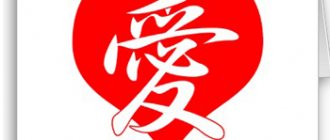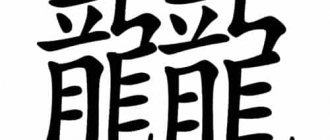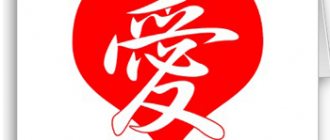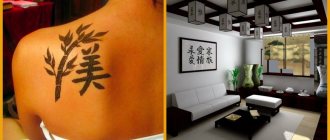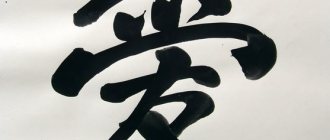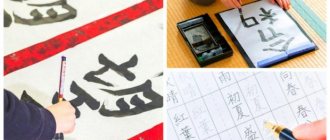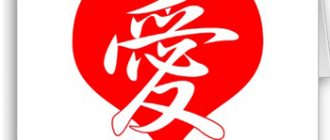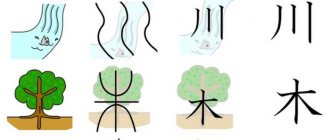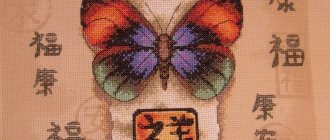Autumn is slowly coming into its own. It's getting cold outside, the sun isn't warming like before. What does the soul want at such a time? Wrap yourself in a blanket, take a hot mug of tea or coffee in your cold hands and have a good rest (or start learning Japanese!). Isn't this a real manifestation of peace, tranquility and harmony ?
Exactly! In this article, three new hieroglyphs are waiting for you, with exactly the same meanings: “peace”, “tranquility” and “harmony”. Stock up on a blanket and a cup of something warm and get started!
"Peace"
There are quite a lot of hieroglyphs with this meaning, but for now we will start with this sign. "Kanji" 安 consists of two elements : "crown, roof" at the top and "woman" at the bottom. The element “crown” is the key of the hieroglyph , by which the sign can be found in the dictionary. His number is 40 .
By the way, this hieroglyph has another meaning – “cheap”.
Pay attention to the order of strokes when writing the sign:
The hieroglyph reads as follows:
They:アン
Kuns:やす(い) – cheap, inexpensive; calm
The association will probably help you remember this sign. As we have already noticed, it is perfectly decomposed into two components - the “roof” and the “woman”. A woman under the roof of a house can symbolize peace, right?
"Kanji" is used in these words :
| Word | Reading | Translation |
| 安全 | あんぜん | safety, security |
| 安心 | あんしん | peace of mind |
| 安価 | あ | low price; cheapness |
| 円安 | えんやす | low yen exchange rate; yen depreciation |
"Freedom"
"Myself"
The character 自 is a single element , “itself” 自, which consists of a dot and an “eye”-like component 目. The entire element 自 is a key – key number 132 .
They:ジ シ
Kun:みずか(ら) – himself; personally
This hieroglyph is pictographic; it used to depict a human nose. If you watch anime, you've probably seen how characters, when talking about themselves, point a finger at their face somewhere near their nose. In China there is also this gesture with the same meaning - pointing to oneself. At first, the character 自 meant nose, but then it was replaced by the kanji 鼻, and the character 自 acquired the meaning “oneself.”
| Word | Reading | Translation |
| 自分 | じぶん | myself; I [myself] |
| 独自 | どくじ | +の original, original, distinctive; personal, individual |
| 各自 | かくじ | every |
| 自然 | しぜん | nature; +な(の)natural, relaxed; +の spontaneous; spontaneous, involuntary; congenital |
"Cause"
The character consists of one element - “rice field” 田 with an elongated vertical line in the middle. The "rice field" component is character key number 102 .
They:ユウユユイ
Kun:よし – reason, basis; means, method; +ある with position; noble origin (about a person); の+です report that...; it is known that…
To help you remember the sign better, we suggest the following mnemonic rule : the “road” (the remainder of the vertical line extending beyond the square) leads to the “field” 田, the poet can “freely” 由 get to it.
| Word | Reading | Translation |
| 理由 | りゆう | reason, basis; motive; occasion; pretext |
| 由来 | ゆらい | origin, source, beginning; story; from ancient times, from time immemorial; by it's nature |
| 経由 | けいゆ | +する to pass, pass (through something) |
| 由緒 | ゆいしょ | origin, pedigree; [long and glorious] history |
Together these "kanji" make up the word "freedom" 自由 (じゆう) . Look how interesting it turns out: “freedom” 自由 is “own” 自 “foundation” 由. The hieroglyphs seem to say that freedom is the very essence of man.
"Calm"
This hieroglyph consists of two parts and three elements : on the left “water” in a truncated form, which is the key of hieroglyph No. 85 , on the right is “mu” on top and “mouth” on the bottom, all together – 台 “support, stand”.
This sign has many meanings - in addition to “calmness” there is also “manage” and “heal”.
They:ジ、チ
Kuny:おさ(める) – to manage, lead; to pacify; settle おさ(まる) – to be peaceful, to be calm; subside; resolve, settle なお(る) – recover なお(す) – treat, cure
The origin of this hieroglyph is associated with legends about the mythical ruler of Ancient China, Yu the Great . He fought the floods that plagued China at that time, but did not change the course of rivers or redirect their flows in the other direction, but built terraces and canals (台) to drain water (水). This is where our two parts come in, as well as the meaning of “calm down, calm down.” Later, the hieroglyph acquired another meaning - “to rule, to manage the state.” This is not surprising, because one of the duties of the sovereigns of China was to protect the population from such floods .
The meaning of "to treat" is associated with medicinal herbs and infusions used in traditional Chinese medicine. This is what “water” represents. The pain of an illness can also be “calmed.”
| Word | Reading | Translation |
| 政治 | せいじ | policy; public administration |
| 統治 | とうち | board, management |
| 治療 | ちりょう | treatment |
| 治安 | ちあん | public peace [and safety] |
On the foot
Men love to get Chinese hieroglyph tattoos on their thighs and calves. For these places it is better to use thicker lines and interesting fonts. Again, no one forbids adding a beautiful drawing.
But on the feet, Japanese characters are found mainly in women. Neat thin lines that make up the hieroglyph decorate a woman’s leg and add elegance. With the help of a small tattoo, your ankle or ankle will look especially feminine.
"Harmony"
This hieroglyph consists of two elements - on the left “ear” and on the right “mouth” , which is the key of hieroglyph number 30 .
Ony:ワ、オ – peace, harmony, harmony
Kuna:やわ(らぐ) – soften; subside, weaken やわ(らげる) – soften; calm down; calm down なご(む) – soften なご(やか) – quiet, calm, peaceful
The ancient form of the character uses an element instead of "mouth" to represent a wind instrument played in ancient China. Perhaps the combination of “ear” and “wind instrument” personifies the Chinese understanding of the word “harmony” - the union of nature and man .
In Japanese, this character has another meaning - “Japan”, “Japanese” . Using this sign, the name of Ancient Japan is written - Yamato 大和.
| Word | Reading | Translation |
| 和服 | わふく | japanese clothing, kimono |
| 平和 | へいわ | peace, harmony |
| 調和 | ちょうわ | harmony, coherence; symmetry |
| 和尚 | おしょう | [Zen] monk; abbot [temple] |
How do you like the new hieroglyphs? Have they brought peace to your heart? Just in case, we remind you that it is better to learn “kanji” by making cards with them and be sure to remember the words that you come across in the texts. Write hieroglyphs more often and repeat them more often . Don’t be afraid to forget a sign - this is an absolutely normal stage of memorization, this is how our brain “records” the information we need. Good luck in learning Japanese!
Japanese characters: “peace”, “tranquility”, “harmony” - we analyze them on our website! Read our articles about how to learn Japanese characters.
Sketches of hieroglyphs and their meaning
The big advantage of this type of tattoo is its simplicity. Almost any adequate master will cope with this task. This fact allows you to save a lot of money on a tattoo artist.
Thus, the price of a tattoo is greatly reduced.
But there is also a big minus. You can easily make a mistake in writing a hieroglyph. Especially when there are several of them, making up the whole inscription. You can make a mistake with translation in the same way. There are a huge number of photos of tattoos on the Internet, where the meaning differs from what was intended.
Many people don’t know, but most hieroglyph tattoos are Chinese and Japanese. There is very little demand for Korean ones. And in Korea itself, tattoos are viewed negatively.
Chinese with translation
The most common hieroglyphs in tattoos are Chinese.
By the way, many people classify Arabic symbols (for example, Egyptian) as hieroglyphs, although this is not entirely correct.
Force
Death
Calm
Happiness
Luck
Success Wealth
Great happiness
Loyalty
Eternal love
Money
Health
Snake
Abundance
Fulfillment of desires
beauty
Love
World
Sea Courage
Independence
Fire
Victory
Prosperity
Japanese with translation
In second place in popularity are Japanese characters. Japan is very fond of tattoos, they even have their own tattoo style of the same name.
Shine
Happiness
Tiger
Luck
Flower
Fabulous
Spring Dragon
Friendship
Spirit Winter Sincerity
beauty
Leopard
Summer
Moonlight
Love
Dream
World
Hope
Autumn
Flight
Rose Sakura
Chinese characters (Feng Shui characters)
Do you know that one of the ways to change your life for the better, bring success into it, improve your financial condition, attract love and happiness, is a Chinese character. At first glance, incomprehensible symbols, squiggles and dashes have magical powers, which are like a prototype of our world, and each represents one or another symbol.
Knowledgeable people who have already experienced the power of hieroglyphs say that for a hieroglyph to “work” it is necessary that it catches your eye as often as possible, and even better, if it is always with you. The Vorobyeva company took care of this, and we created gold hieroglyph pendants that can be worn on a chain, thus, the hieroglyph will always be near you and will work as an identification, i.e. will attract the qualities that it symbolizes.
Next, we will offer you proven and valid hieroglyphs talismans:
Hieroglyph "Love"
In order to meet your love or increase your existing one, the Chinese character for “love” can help. It has been proven that it really magically brings its owner luck in love, helps to mend existing relationships if they have cracked, makes relationships deeper and more harmonious, and helps unmarried girls meet their soul mate. Usually its owners don’t even have to look for love, and fate simply brings future lovers together.
Hieroglyph "Double Happiness"
Another one of everyone’s favorite hieroglyphs is double happiness, which is a powerful talisman. It helps fill relationships with love, mutual understanding, make your desires come true, and will bring success in business and other matters. This hieroglyph works very well to attract happiness in tandem, that is, for two or more people.
Hieroglyph "Happiness"
If you are at a crossroads in life and have no idea what to do, this hieroglyph will help move you in the right direction and bring happiness and joy into your life. This hieroglyph gives its owner inspiration. Helps you succeed in the area in which you would like to develop. Brings peace of mind.
Hieroglyph "Wealth"
This hieroglyph helps not only to increase your income, but will also help in life and your affairs in general. You can wear it not only around your neck as a pendant, but also put it in your wallet, thereby it will work for profitability and improve financial flows.
Hieroglyph "Prosperity"
This sign can work in different areas: help in love, attract happiness. It attracts good luck very well. It also helps to preserve existing capital and increase it, increasing well-being.
Hieroglyph "Money"
If you want to improve your financial condition and increase your income, then you need to purchase the hieroglyph “money”. It helps you create multiple sources of income from which you can make good profits. It is very good to have it for people who do business.
Hieroglyph "Abundance"
A very strong sign among Chinese characters. It attracts exactly what its owner strives for most. Helps and gives abundance in different areas of life, brings different benefits. It helps its owner in financial areas, bringing both well-being and wealth, helping to improve health and career advancement. If you are planning a project, then this symbol will help you make your project successful. It also helps creative people and attracts fame.
It has been proven that a hieroglyph in the form of a pendant very quickly begins to work and attract what is contained in it. This happens because it constantly exchanges energy with its owner, coming into contact with the body. Therefore, it is recommended that you never part with him and that he always be with you. Hieroglyphs made of gold allow you to wear them 24 hours a day, since gold jewelry does not deteriorate, does not darken, and always looks like new.
It is very important to believe in the power of the hieroglyph, that it will soon help you achieve your goals and fulfill your desires. Because if you are skeptical about these symbols, they will simply remain symbols and will not provide energy. We wish everyone happiness and fulfillment of desires!
Photos of tattoos
Even if you have chosen a suitable sketch for yourself above in the article, the question still remains: how it will look on the body in the form of a tattoo. That's why we've put together a photo catalog of ready-made tattoos for guys and girls.
Click on the picture to enlarge the photo.
For men
The male part of the population chooses Chinese tattoos of hieroglyphs, denoting truly masculine qualities: courage, strength, bravery, devotion, etc. It can also be the name of an animal:
- A lion;
- Tiger;
- The Dragon.
Tattoos of hieroglyphs with philosophical meaning are no less popular:
- Health;
- Wealth;
- Luck.
For women
Girls also love tattoos of hieroglyphs with the names of animals in Chinese. But they prefer not predators, but cuter creatures:
- Cat;
- Fox;
- Panda.
In terms of life values, women have relevant hieroglyphs with meanings in Russian:
- Happiness;
- Love;
- Family.
Chinese horoscope
Bull
The Dragon
Snake
Goat
Rabbit
Rat
Horse
Monkey
Rooster
Pig
Dog
Tiger
